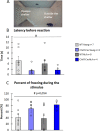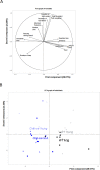Characterization of social behavior in young and middle-aged ChAT-IRES-Cre mouse
- PMID: 35925937
- PMCID: PMC9352053
- DOI: 10.1371/journal.pone.0272141
Characterization of social behavior in young and middle-aged ChAT-IRES-Cre mouse
Abstract
The cholinergic system is an important modulator of brain processes. It contributes to the regulation of several cognitive functions and emotional states, hence altering behaviors. Previous works showed that cholinergic (nicotinic) receptors of the prefrontal cortex are needed for adapted social behaviors. However, these data were obtained in mutant mice that also present alterations of several neurotransmitter systems, in addition to the cholinergic system. ChAT-IRES-Cre mice, that express the Cre recombinase specifically in cholinergic neurons, are useful tools to investigate the role of the cholinergic circuits in behavior. However, their own behavioral phenotype has not yet been fully characterized, in particular social behavior. In addition, the consequences of aging on the cholinergic system of ChAT-IRES-Cre mice has never been studied, despite the fact that aging is known to compromise the cholinergic system efficiency. The aim of the current study was thus to characterize the social phenotype of ChAT-IRES-Cre mice both at young (2-3 months) and middle (10-11 months) ages. Our results reveal an alteration of the cholinergic system, evidenced by a decrease of ChAT, CHT and VAChT gene expression in the striatum of the mice, that was accompanied by mild social disturbances and a tendency towards anxiety. Aging decreased social dominance, without being amplified by the cholinergic alterations. Altogether, this study shows that ChAT-IRES-Cre mice are useful models for studying the cholinergic system's role in social behavior using appropriate modulating technics (optogenetic or DREADD).
Conflict of interest statement
The authors have declared that no competing interests exist.
Figures










Similar articles
-
Altered Baseline and Nicotine-Mediated Behavioral and Cholinergic Profiles in ChAT-Cre Mouse Lines.J Neurosci. 2018 Feb 28;38(9):2177-2188. doi: 10.1523/JNEUROSCI.1433-17.2018. Epub 2018 Jan 25. J Neurosci. 2018. PMID: 29371319 Free PMC article.
-
Generation of a ChATCre mouse line without the early onset hearing loss typical of the C57BL/6J strain.Hear Res. 2020 Mar 15;388:107896. doi: 10.1016/j.heares.2020.107896. Epub 2020 Jan 20. Hear Res. 2020. PMID: 31982642 Free PMC article.
-
Cholinergic neurons in the dorsomedial hypothalamus regulate food intake.Mol Metab. 2017 Jan 12;6(3):306-312. doi: 10.1016/j.molmet.2017.01.001. eCollection 2017 Mar. Mol Metab. 2017. PMID: 28271037 Free PMC article.
-
Cholinergic circuits in cognitive flexibility.Neuroscience. 2017 Mar 14;345:130-141. doi: 10.1016/j.neuroscience.2016.09.013. Epub 2016 Sep 15. Neuroscience. 2017. PMID: 27641830 Review.
-
The high-affinity choline transporter: a critical protein for sustaining cholinergic signaling as revealed in studies of genetically altered mice.Handb Exp Pharmacol. 2006;(175):525-44. doi: 10.1007/3-540-29784-7_21. Handb Exp Pharmacol. 2006. PMID: 16722248 Review.
Cited by
-
Loss of GABA co-transmission from cholinergic neurons impairs behaviors related to hippocampal, striatal, and medial prefrontal cortex functions.Front Behav Neurosci. 2022 Nov 24;16:1067409. doi: 10.3389/fnbeh.2022.1067409. eCollection 2022. Front Behav Neurosci. 2022. PMID: 36505727 Free PMC article.
-
Xanomeline restores endogenous nicotinic acetylcholine receptor signaling in mouse prefrontal cortex.Neuropsychopharmacology. 2023 Mar;48(4):671-682. doi: 10.1038/s41386-023-01531-5. Epub 2023 Jan 12. Neuropsychopharmacology. 2023. PMID: 36635596 Free PMC article.
-
Psilocybin as Transformative Fast-Acting Antidepressant: Pharmacological Properties and Molecular Mechanisms.Fundam Clin Pharmacol. 2025 Aug;39(4):e70038. doi: 10.1111/fcp.70038. Fundam Clin Pharmacol. 2025. PMID: 40670864 Free PMC article. Review.
-
Chronic neuroinflammation during aging leads to cholinergic neurodegeneration in the mouse medial septum.J Neuroinflammation. 2023 Oct 13;20(1):235. doi: 10.1186/s12974-023-02897-5. J Neuroinflammation. 2023. PMID: 37833764 Free PMC article.
-
A sex-specific effect of M4 muscarinic cholinergic autoreceptor deletion on locomotor stimulation by cocaine and scopolamine.Front Mol Neurosci. 2024 Dec 16;17:1451010. doi: 10.3389/fnmol.2024.1451010. eCollection 2024. Front Mol Neurosci. 2024. PMID: 39737113 Free PMC article.
References
MeSH terms
Substances
LinkOut - more resources
Full Text Sources
Molecular Biology Databases

